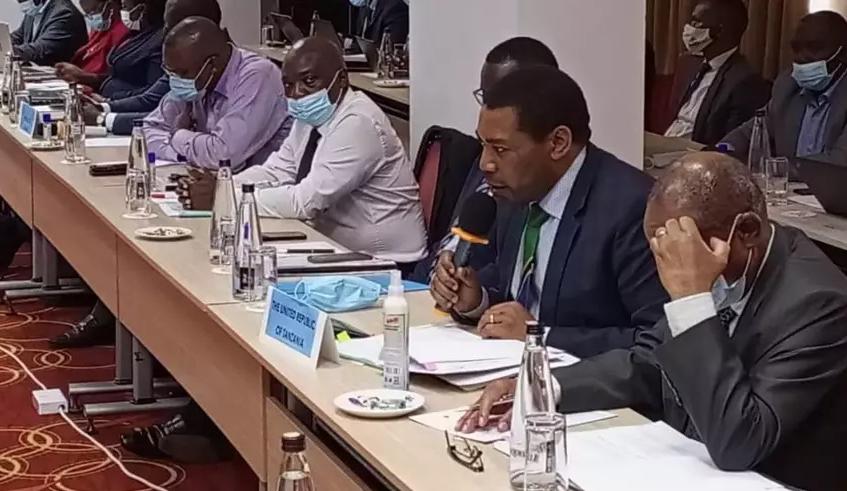Africa-Press – Rwanda. The East African Business Council (EABC), the top regional body of private sector associations and corporates, is proposing that partner states should adopt a 35 per cent maximum Common External Tariff (CET) rate, The New Times has learned.
The development comes after drawn-out negotiations, involving stakeholders from the six-member bloc, highlighting divergent positions regarding a maximum CET rate of 30 per cent or 35 per cent.
The regional CET reflects the trade relations between the partner states and the rest of the world particularly import duty charged on imported products into the bloc.
The Confederation of Tanzania Industries (CTI), Uganda Manufacturers Association (UMA) and Kenya Association of Manufacturers (KAM) are pushing for 35 per cent while the Rwanda Association of Manufacturers (RAM) and Association des Industrielles du Burundi (AIB) support a 30 per cent tariff rate.
John Bosco Kalisa, CEO of the East African Business Council (EABC), told The New Times that the EABC view is, clearly, that 35 per cent is appropriate to spur industrialisation and boost intra-regional trade.
“It had been a challenge and the council of ministers needs to make a firm decision and agree on a middle ground to enable trade to take place,” Kalisa said. Ministers in charge of EAC affairs are scheduled to meet from November 26 to 27.
“Last week during the Sectoral Council on Customs, Trade and Investment — a decision was made that this need to be fast-tracked and implementation need to start 1st July 2022. Let us see what the Council of Ministers decides on this, next week, will be.”
The EABC recommends, among others, that partner states should adopt 35 per cent as the maximum EAC CET rate to provide adequate tariff differential required to incentivize industrial development in the region; and that a maximum CET rate will safeguard goods that are sufficiently available or produced in the region against import surges from countries adopting unfair trade practices.
They claim that the maximum CET rate will protect nascent industries exposed to unfair competition from cheap or subsidised imports. The last meeting of the regional task force held in Uganda, last month, to carry out a comprehensive review of the CET agreed on, among others, a four band tariff structure of 0 per cent, 10 per cent, 25 per cent and a rate above 25 per cent which is either 30 per cent or 35 per cent.
The implementation of the bloc’s CET commenced in January 2005 after the coming into force of the EAC Customs Union Protocol. It is now structured under three bands of 25 per cent for finished goods, 10 per cent for intermediate goods and zero percent for raw materials and capital goods.
Furthermore, there are a limited number of products under the sensitive list that attract rates above the maximum rate of 25 per cent ranging between 35 per cent and 100 per cent.
In total, the EAC-CET which was last reviewed in 2010 and the three-band rate structure maintained, covers a total of 5,395 tariff lines at an eight-digit level.
Each year, partner states through EAC pre-budget consultations of the Ministers of Finance do annual reviews on specific products and, according to the EABC, these reviews have been manifested with an increase or decrease of duty rates for specific products depending on product availability in the region.
As noted, the main challenges about these annual reviews are on how to strike a delicate balance between conflicting interests ranging from revenue considerations, support for infant industries; affordability, high quality and sufficient availability of inputs to allow for competitive upstream industries; and sufficient supply of high-quality products at affordable prices for consumers.
Arguments against proposed 35 per cent tariff rate
The arguments of CTI, KAM and UMA in support of the 35 per cent as maximum CET rate include that: 35 per cent provides adequate tariff deferential required for incentivizing industrial investments in the region.
They also argue that products identified for fourth band by the regional task force are those manufactured in insufficient quantities in the region; and that many products are currently lumped in the third band of 25 per cent rate which is for products not available in the region.
On the other hand, the arguments of AIB, RAM and the South Sudan Chamber of Commerce, Industry and Agriculture (SSCCIA) in support of 30 per cent as maximum tariff rate are: the low level of industrialization in their respective countries; need to protect the welfare of the people by charging low rates, and that tariff protection is not the only avenue for addressing competitiveness in EAC against products from Asian countries.
The issue, by and large, is that while a rate of 35 per cent would be fair to larger economies with products to protect, a lower rate benefits smaller economies like Rwanda and Burundi.
In view of the above arguments, the EABC is proposing that partner states adopt a 35 per cent as maximum CET rate, as this rate provides adequate tariff differential which is required to incentivise industrial development in the region.
The regional body notes that the proposal of 30 per cent will merely create a five per cent tariff differential with the third tariff band of 25 per cent while the 35 per cent will create a tariff differential of 10 per cent which will safeguard products that are sufficiently produced in the region against similar cheap imports.
Accordingly, the 10 per cent tariff differential is needed to safeguard and retain existing investments which operate the regional value chain and attract new investments to transform the region’s industrial sector by transforming secondary intermediates into finished products.
Their other reason is that products to be assigned the maximum CET rate (fourth tariff band) by the regional task force are those that are only sufficiently available or produced in the region.
The EABC also argues that the proposed 35 per cent tariff rate is expected to promote both consumption of locally manufactured goods and the regional value chain.
For More News And Analysis About Rwanda Follow Africa-Press






